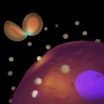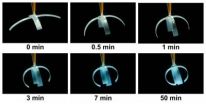(Press-News.org) CHESTNUT HILL, MA (Nov. 20, 2012) – The executive pay provisions of the TARP – the Troubled Asset Relief Program – stoked controversy. Bankers claimed the rules would thwart their efforts to attract and retain the best executives. But the pay rules may have had an unintended benefit of reducing the scope of the program, researchers say.
A newly published report in the Journal of Banking, Finance & Accounting finds that pay provisions did discourage some banks from participating in TARP, which was intended to help banks weather the 2008-2009 financial crisis, according to researchers Mary Ellen Carter of Boston College, Brian Cadman, of the University of Utah, and Luann J. Lynch, of the University of Virginia.
Examining 263 publicly traded banks that were approved for TARP, the new study found that 35 banks rejected the funds and that this decision was related to higher levels of CEO pay. But this decision didn't seem to hurt them – they fared just as well as their peers that did take TARP money. As a result, the pay provisions in TARP may have deterred banks that didn't really need the money from taking it.
The study also suggests that from a personal standpoint bankers may have been right to worry about TARP's pay limits: banks that took the funds did see higher executive turnover than those that didn't. But their performance didn't suffer. Banks that turned down TARP money—often derisively referred to as "bailouts"— did just as much lending afterwards and had just as much financial strength, measured in terms of capital ratios, as those that accepted it.
"While we don't know exactly why these banks refused the funds, we do know that some high-profile bankers complained that the pay restrictions were onerous. Our study suggests that TARP may have been better designed than bankers would have you believe," Carter said. "The restrictions gave financial incentives for bank executives to think carefully about participating and, if they did participate, to get out from underneath the program as quickly as possible."
TARP was, perhaps, the most controversial of the many policy measures undertaken during the financial crisis. The U.S. government originally budgeted $700 billion and ultimately paid out about $400 billion to shore up the U.S. financial system. Some viewed the program as corporate welfare while others saw it as creeping socialism. Nobody, but the bankers who needed the money, seemed to like it much. But in the end, TARP appears to have succeeded: banks, for the most part, survived the crisis and are paying back the money.
###The full report, "Executive Compensation Restrictions: Do They Restrict Firms' Willingness to Participate in TARP", is available at the following link: http://papers.ssrn.com/sol3/papers.cfm?abstract_id=2167183.
Executive pay limits narrowed scope of TARP banking rescue
New study finds rejecting TARP funds related to limits on CEO pay
2012-11-21
ELSE PRESS RELEASES FROM THIS DATE:
Seals gamble with their pups' futures
2012-11-21
Some grey seal mums adopt risky tactics when it comes to the future of their young, a strategy that can give their pup a real advantage, according to scientists.
Researchers from Durham University, UK, and the University of St Andrews, looking at grey seal colonies in Scotland, found that some seal mothers are flexible in the parenting style they adopt and 'gamble' on the outcome of their actions, whilst other play it safe and steady.
The study is the first to demonstrate how variation in personality traits in large marine mammals in the wild can persist, rather than ...
New American Chemical Society video series shines a light on transparent solar cells
2012-11-21
WASHINGTON, Nov. 20, 2012 — The American Chemical Society (ACS) today launched a new video series that highlights headline-making research from the society's suite of more than 40 peer-reviewed scientific journals. The first episode of Breakthrough Science focuses on research reported in one of those journals, ACS Nano. It involved development of new transparent solar cells, an advance toward giving windows in homes and other buildings the ability to generate electricity while still allowing people to see outside.
The video is available at http://pubs.acs.org/page/videos/breakthroughscience.html.
Breakthrough ...
Researchers find decline in availability and use of key treatment for depression
2012-11-21
Providence, RI - - Electroconvulsive therapy (ECT) is considered the most effective treatment option for patients with severe depression who cannot find symptom relief through antidepressant medications or psychotherapy. In a new study, researchers at Butler Hospital and Bradley Hospital in Rhode Island found a sharp decline in the availability and use of ECT in general hospitals across the U.S. The findings were published online in the journal Biological Psychiatry on October 10, 2012.
The researchers analyzed data from a nationally representative survey of US general ...
New method helps target Parkinson's disease
2012-11-21
Health professionals may soon have a new method of diagnosing Parkinson's disease, one that is noninvasive and inexpensive, and, in early testing, has proved to be effective more than 90 percent of the time.
In addition, this new method has the potential to track the progression of Parkinson's, as well as measure the effectiveness of treatments for the disorder, said Rahul Shrivastav, professor and chairperson of Michigan State University's Department of Communicative Sciences and Disorders and a member of the team developing the new method.
It involves monitoring a ...
Tiny probes shine brightly to reveal the location of targeted tissues
2012-11-21
Called BRIGHTs, the tiny probes described in the online issue of Advanced Materials on Nov. 15, bind to biomarkers of disease and, when swept by an infrared laser, light up to reveal their location.
Tiny as they are, the probes are exquisitely engineered objects: gold nanoparticles covered with molecules called Raman reporters, in turn covered by a thin shell of gold that spontaneously forms a dodecahedron.
The Raman reporters are molecules whose jiggling atoms respond to a probe laser by scattering light at characteristic wavelengths.
The shell and core create an ...
IUDs don't cause pelvic inflammatory disease in women
2012-11-21
The risk of developing pelvic inflammatory disease (PID) following insertion of an intrauterine device (IUD) is very low, whether or not women have been screened beforehand for gonorrhea and chlamydia, according to a joint study of nearly 60,000 women by researchers at the University of California, San Francisco (UCSF), and Kaiser Permanente Northern California Division of Research.
The study appears this week in the current online issue of Obstetrics & Gynecology, the official journal of the American College of Obstetricians and Gynecologists, also known as Green Journal.
The ...
New electrically-conductive polymer nanoparticles can generate heat to kill colorectal cancer cells
2012-11-21
WINSTON-SALEM, N.C., – Nov. 20, 2012 – Researchers at Wake Forest Baptist Medical Center have modified electrically-conductive polymers, commonly used in solar energy applications, to develop revolutionary polymer nanoparticles (PNs) for a medical application. When the nanoparticles are exposed to infrared light, they generate heat that can be used to kill colorectal cancer cells.
The study was directed by Assistant Professor of Plastic and Reconstructive Surgery, Nicole H. Levi-Polyachenko, Ph.D., and done in collaboration with colleagues at the Center for Nanotechnology ...
Natural fungus may provide effective bed bug control
2012-11-21
UNIVERSITY PARK, Pa. -- "And don't let the bed bugs bite" is no longer a harmless adage. In reality today, these bloodthirsty bugs infest thousands of homes. According to a team of Penn State entomologists, biopesticides -- naturally occurring microorganisms -- might provide an answer to this pest problem.
Bed bugs need blood meals for growth and development throughout their life cycle. Increased travel, widespread insecticide resistance and changes in management practices have caused a resurgence in those insects throughout North America and Europe. Compounding the problem ...
Scotch tape finds new use as grasping 'smart material'
2012-11-21
WEST LAFAYETTE, Ind. – Scotch tape, a versatile household staple and a mainstay of holiday gift-wrapping, may have a new scientific application as a shape-changing "smart material."
Researchers used a laser to form slender half-centimeter-long fingers out of the tape. When exposed to water, the four wispy fingers morph into a tiny robotic claw that captures water droplets.
The innovation could be used to collect water samples for environmental testing, said Babak Ziaie, a Purdue University professor of electrical and computer engineering and biomedical engineering.
The ...
Adenotonsillectomy may help resolve obstructive sleep apnea in children with Prader-Willi syndrome
2012-11-21
Children with Prader-Willi syndrome may receive relief from sleep disorders after undergoing an adenotonsillectomy, suggests a new study from Nationwide Children's Hospital published in the November print issue of the Archives of Otolaryngology-Head and Neck Surgery.
"Patients with Prader-Willi syndrome are at risk for sleep disordered breathing as growth hormone commonly used to treat their condition can cause the tonsils and adenoids to enlarge," said the study's lead author Kris Jatana, MD, FAAP, with Otolaryngology Head & Neck Surgery at Nationwide Children's.
"Growth ...
LAST 30 PRESS RELEASES:
Australian team discover why quantum computers have memory problems over time
What determines the fate of a T cell?
Candida auris: genetic process revealed which could be treatment target for deadly fungal disease
Groundbreaking discovery turns household plastic recycling into anti-cancer medication
Blocking a key inflammatory pathway improves liver structure and vascular function in cirrhosis, study finds
Continuous spread: Raccoon roundworm detected in nine European countries
HKUST Engineering researchers developed a novel photodetector to enhance the performance of on-chip light monitoring
Strategic river sensors could have forewarned of Texas Camp flood disaster
Drone sampling of whale breath reveals first evidence of potentially deadly virus in Arctic
Roman soldiers defending Hadrian’s Wall infected by parasites, study finds
Pinochet’s prisoners were tormented with music but still found solace in it, a new book reveals
Fertility remains high in rural Tanzania despite access to family planning
AI-assisted device can improve autism care access
Kinetic careers
Uncovering how parasitic plants avoid attacking themselves to improve crop resistance
Nanoparticle vaccine strategy could protect against Ebola and other deadly filoviruses
Study finds brain care score can predict risk of stroke across racial groups
Key lung immune cells can intensify allergic reactions
Do hormones explain why women experience more gut pain?
New materials conduct ions in solids as easily as in liquids
Breakthrough of the Year: Renewable energy begins to eclipse fossil fuel-based sources
LLM use is reshaping scientific enterprise by increasing output, reducing quality and more
Introducing LightGen, a chip for ultra-fast, ultra-efficient generative AI
Astronomers see fireworks from violent collisions around nearby star
ACC/AHA issue new guideline on managing congenital heart disease in adults
Cosmic crash caught on camera
Is talented youth nurtured the wrong way? New study shows: top performers develop differently than assumed
Ants: An untapped resource in the development of antibiotics?
Archaeologists use AI to create prehistoric video game
Mitochondria migrate toward the cell membrane in response to high glucose levels
[Press-News.org] Executive pay limits narrowed scope of TARP banking rescueNew study finds rejecting TARP funds related to limits on CEO pay




